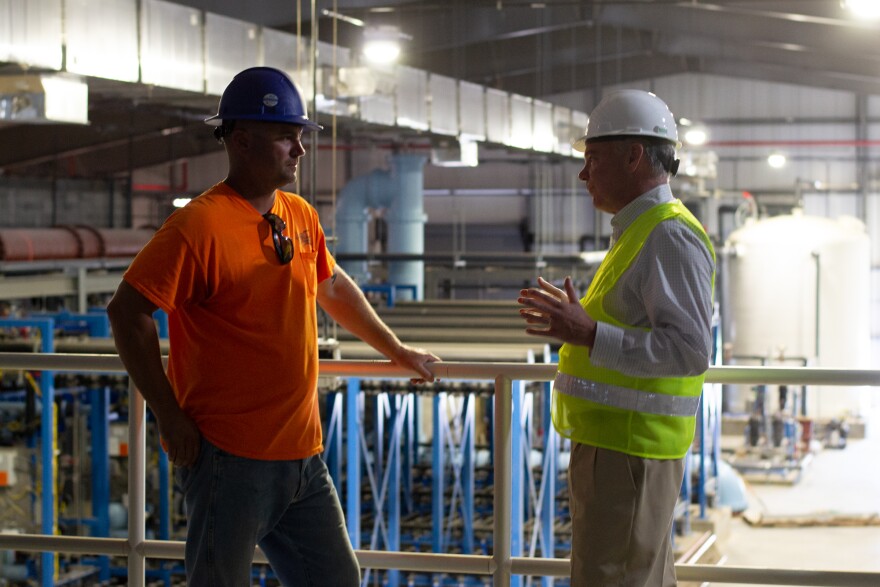Senator Tim Kaine visited the northern end of the Shenandoah Valley on Thursday to promote local education and infrastructure projects. WMRA's Randi B. Hagi reports.
[sound of group walking down the hall]
Staff from Winchester City Public Schools led Senator Tim Kaine through the halls of the newly renovated Emil & Grace Shihadeh Innovation Center, where middle and high schoolers can take career and technical education, or CTE courses. Among other teachers, they visited Moe Bruce, who teaches EMT classes.

MOE BRUCE: My main goal is to, number one, get you all certified, nationally registered as an EMT, and then hopefully utilize that by getting out in the community and volunteering with fire departments, rescue squads, hospitals …
KAINE: If you moved across the country, they may not know what Handley High School is, but they will know what the EMT national certification is.
Kaine said he's long been a supporter of career and technical education because his father ran a welding and ironwork business. Last year, Kaine introduced the JOBS Act in the Senate, which would make students taking shorter-term certification programs at community colleges eligible for federal Pell Grants. One example he gave is an eight-week program for data center technicians.
KAINE: So Virginia has suddenly become the home of all this data center traffic. And those centers have needs for a particular workforce … and a lot of people who are interested in it are career-switchers.
Kaine said he has about 55 cosponsors for the JOBS Act, and more senators who'd be willing to vote for it, if he can attach it to a larger bill.

Next on the tour was a stop at the Henry F. Sliwinski water treatment plant out in Frederick County. The plant is currently under construction, and while supply chain issues have caused delays, the public water utility is hoping it'll be completed by the end of this year. Kaine, together with Senator Mark Warner, was able to get $3.6 million for the plant's construction out of congressionally directed spending.
The plant's raw water source is the ground- and rainwater that collects in a limestone quarry run by the company Carmeuse.
ERIC LAWRENCE: In working with Carmeuse, they have a couple different quarries. We're working to help pump all the water that they don't want in their quarry down to the east pit, which is where we have our pump structure.
Eric Lawrence is the executive director of the water utility.
LAWRENCE: And once we have that installed over the next year, we should have five, six million gallons of water replenishing to help this plant continue to operate and make sure our community has water.
Because their water comes from the quarry, they're insulated from events like algal blooms that affect the health of the Shenandoah River, where Winchester and other localities get their water. Lawrence said that last year, during a bloom, the Virginia Department of Health asked Frederick County to prepare to share their water in case Winchester needed to stop drawing from the river.
LAWRENCE: Fortunately, we got a downpour and it cleaned up the river. But that's one of the advantages of using the quarry system and the groundwater system, is we don't have to worry about the algae blooms that show up in August and September.
KAINE: My … preconception would have been that river or creek water was cleaner than quarry water, but I'm wrong about that, aren't I, Eric?

LAWRENCE: The quarry water is crystal clear.
The Senator and his staff then drove down to Front Royal, where they celebrated the newly-dubbed George Banks Boulevard with his family and friends. Banks, who was the town's first Black town councilman and mayor, died earlier this year.
[sound of people in background]
CORNELIA BANKS: I miss him. [chuckles] So, we would have been married 52 years next month.
Cornelia Banks hosted the gathering outside her home. She and George moved to Front Royal 48 years ago, and he quickly started attending town council meetings.
BANKS: He came home, I guess after a year, and he said, "you know what? I'm going to run for city council." I said, "George, really? … I support you and everything."
She may have been a tad bit skeptical, but she helped with the campaign – and he won. Banks went on to serve two terms as a council member, and one as mayor. The street by their home was officially renamed George Banks Boulevard in June.
BANKS: It's just – I get teary-eyed every time I see it.



